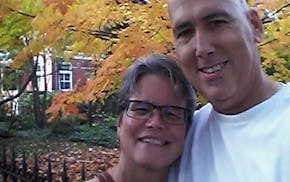In August 1963, Martin Luther King Jr. stood on the steps of the Lincoln Memorial in Washington and made his lyrical call for peace and nonviolence. Let freedom ring, he preached, from the mountains of New York to the slopes of California.
Bill Jeter was a young man then, blessed and cursed with the common traits of many young men during the peak of the civil rights movement. He was rebellious and impatient, and King's words didn't resonate with him as much as the words of some other leaders of the time, such as Malcolm X.
"We wanted things fast; we wanted things now," said Jeter.
Years later, however, he stumbled across King's book "Strength to Love," given to him long ago by a friend. "I picked it up and read it, and it really changed the way I started thinking about Martin Luther King," he said.
Jeter was moved by King's wisdom, by his pleas for nonviolence and reconciliation. Sitting in his sun-dappled space at Homewood Studios on Plymouth Avenue N. on Sunday, Jeter said the words are as salient now as they were decades ago.
"In these turbulent days of uncertainty, the evils of war and of economic and racial injustice threaten the very survival of the human race," is how King began the book.
Just as King's "I Have a Dream" speech and his murder were catalysts for change, the Jan. 8. attempted assassination of U.S. Rep. Gabrielle Giffords in Tucson, Ariz., could be another such moment, he said.
He also hopes that his current art project might be, on a much smaller and personal scale, a spark for a community conversation. For nearly three years, in his spare time away from his job teaching art at the Perpich Center for Arts Education, Jeter has been crafting a small bell, which he will someday cast in bronze. The bell was inspired by King's "Dream" speech, with its "let freedom ring" refrain.
For Jeter, who got his master's degree from the Minneapolis College of Art and Design, each King Day has been a marker, and a reminder, of his plan to take the form he lathed from a stump and make it into an art object that tells a story and, he hopes, generates more. It's not so much a dream, he says, as a goal he wants to accomplish.
After the bell is finished, Jeter hopes to bring it to the places mentioned in King's speech, from Stone Mountain in Georgia to the hills of Tennessee, on the 50th anniversary of King's speech in 2013.
"I analyzed the speech and said, this is something I can do, something that can maybe start a conversation in those communities about" issues such as race and poverty and war, he said.
Jeter, who moved to Minnesota from the East Coast because he was impressed with the diversity of the local arts community, has been involved in many community art projects and knows they can be starting points for communication. For instance, he said, when he took his art to a small western Minnesota town where he was the only black person for miles around after the 1991 police beating of Rodney King in Los Angeles, people felt they could ask him how he felt about that controversy.
"I'm not going to transform people's lives with a bell," he said. "But as a teacher, I know that sometimes it's the little things you do or say that kids come back and remember years later. If it was just about making a bell, I wouldn't be doing this. It's about the community interaction and cooperation."
So Jeter will keep at it, on quiet Sunday mornings, crafting his bell, pouring the wax mold and finally the bronze, determined that freedom will some day ring loud and clear from at least one small corner of America.
jtevlin@startribune.com • 612-673-1702

Tevlin: 'Against all odds, I survived a career in journalism'

Tevlin: Grateful Frogtown couple fight their way back from fire and illness



